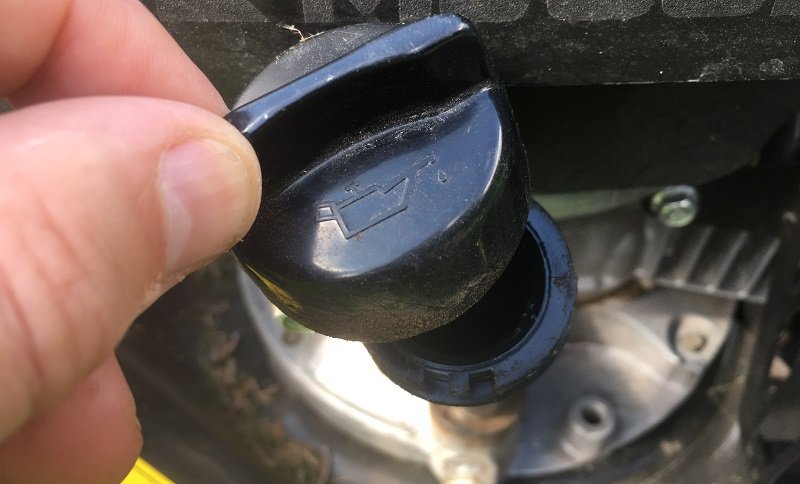Manufacturers such as Troy Bilt make lawn mowers in both residential and commercial versions ranging from small to big. On top of this, you can buy a Troy Bilt with an engine from Briggs & Straton, Honda, Kohler, or even their own. This huge selection of lawn mowers can make it challenging to work out how much oil your mower needs. So, where do you start when trying to work out lawn mower oil capacity? Well, let’s take a look at where you need to look to figure out how much oil to put in your lawn mower.

How Much Oil Does a Lawn Mower Take? (The Short Answer)
Lawn mower engines vary in size and power. The oil requirement differs depending on the specification of the engine. There isn’t one specific volume of oil that suits all lawn mower engines. Oil requirements can range from 15 oz to 70 oz, depending on the lawn mower’s oil capacity.
Oil Capacity is Not Universal: It Varies According to the Type of Mower You Have
Oil capacity all depends on the specific engine. Lawn mower manufacturers, product names, and model numbers are not enough to work out the capacity. For example, Briggs & Stratton is a huge engine manufacturer that provides engines for several big-name lawn mower manufacturers. They have 5 engines in their range with 32 total variations that have 5 different oil capacity requirements. Now, if you wanted to include their sister company, Vanguard, which also makes lawn mower engines, this number would nearly double.
So, if you add all the manufacturers, lawn mower types, and engine variations, you end up with hundreds, if not thousands, of different lawn mowers. As a result, there’s a vast range of different oil capacities and not one universal answer.
Here’s the Briggs & Stratton engine range to give you an idea of the number of engines they manufacture and how the oil capacities vary.
Briggs & Straton Engine Range
| Engine Series | Mower Type | Engine Size | Oil (oz) | Engine Variations |
|---|---|---|---|---|
| E Series | Push | 125 - 140 cc | 15 | 2 |
| E Series | Riding | 344 - 500 cc | 48 | 5 |
| XE Series | Push | 140 - 150 cc | 15 | 2 |
| XE Series | Riding | 344 - 500 cc | 48 | 6 |
| XEi Series | Push | 150 - 190 cc | 15 | 3 |
| XEi Series | Riding | 656 - 724 cc | 64 | 2 |
| PXi Series | Push | 190 - 223 cc | 18 | 2 |
| PXi Series | Riding | 656 - 724 cc | 64 - 67 | 4 |
| CXi Series | Riding | 656 - 810 cc | 64 - 67 | 6 |
The Easiest Way to Know How Much Oil to Put in Your Mower
The first thing you need to know when it comes to figuring out how many quarts of oil does your lawn mower take is the name and model of the engine. Most engines will have the manufacturer’s name and the specific model number printed directly on the engine. Once you have this information, you can either search directly on the manufacturer’s website or in the manual if you still have it.
Usually, when you buy a new lawn mower, you’ll be provided a manual for the actual lawn mower itself and one for the engine. If you happen to buy a mower like a Toro, a manufacturer that makes both their mowers and engines, the oil capacity could be in the same manual. But Toro also uses other manufacturers’ engines, so the engine’s oil capacity could be in a separate manual.
Basically, find the printed information specific to your engine since things can easily become very complicated.
How to Make Sure You Add the Right Amount of Oil to Your Mower (Step By Step)
Once you get hold of the correct information on how much oil goes into your lawn mower, it’s time to either top it off or give it a complete fill depending on your situation.
As you use your lawn mower, the oil degrades. The oil will burn off during this period and need to be topped off. Once a set period has passed, the oil will need to be changed. The period of how often to change your lawn mower oil can vary on several factors, including hours of use and how hard the mower has been working.
The common factor between topping off and oil changes is that the oil must be filled to a specific level at all times. Here are the steps you’ll need to follow to make sure you fill the engine with the right amount of oil.
Adding Oil to Your Lawn Mower the Right Way
Regardless of whether you are topping off or filling the engine from dry, the method used is the same. So, grab the following tools and parts, and let’s get started.
Tools & Parts Needed to Add Oil to Your Lawn Mower
- Engine Oil
- Shop Rag
- Oil Funnel
Locate the Dipstick
The first step in checking your oil is to check the oil level. The level is checked using the same method regardless if it’s low or empty. So, located on the engine is an oil dipstick. Some lawn mowers have an individual dipstick, and some have a dipstick as part of the filler cap. So, if you can’t find the dipstick, take a look inside the oil filler cap.
Remove & Clean the Dipstick
After you have found the dipstick, remove it from the engine and give it a wipe-down. You want to use your shop cloth and remove all the oil from the end of the dipstick so that it’s ready to test the oil level.
Replace the Dipstick
Take your clean dipstick and place it back into the engine. Now, some engines require you to replace the dipstick completely, and some want you only to replace it until you feel resistance. So, I’d recommend that you have a look in the manual and check what your engine requires.
Remove the Dipstick & Check the Oil Level
The next step is removing the dipstick. Pull the dipstick out of the engine, being careful not to touch the end of the stick on anything, as this is where you need to check.
If you take a look at the bottom of the dipstick, you’ll see some markings. Low and full. If you are topping off,the oil should sit between these two marks. For you guys who are filling the engine from dry, you won’t need to check the dipstick at this point.
Adding Oil to the Engine
Once you have researched how much oil your push mower takes or how much oil your riding lawn mower takes, it’s time to fill or top off your engine. So, take your funnel and begin to pour the oil into the oil filler.
If you are filling your engine from dry, then I’d recommend that you fill 75% of the capacity. So, if your engine needs 20oz, fill it with 15oz, then check the level. For you guys who are topping off, just add 1oz at a time. It’s much easier to add oil than it is to remove it. So, take it nice and slow.
Check the Oil Level & Fill as Needed
Once you think you have 75% of the engine filled, check the oil level using the dipstick the same way you did when you first checked the level. Now, add more oil in single oz fills. Doing it this way is going to avoid overfilling. Repeat this process until the dipstick reads between the low and full marks. You should be aiming for closer to the full level, but definitely not over.
Run the Engine
Before you put the tools away, you should run the lawn mower for a couple of minutes. This pushes the oil around the engine getting into all the different areas. If you have just changed your oil filter, this process will help fill it up.
After the mower has been running for a while, switch it off and let it cool down. This allows the oil to settle back in the bottom of the engine so you can get an accurate level check.
Re-Test the Oil Level
Once the engine has cooled down, recheck the oil level. You’ll probably find that the level has gone down and the engine needs more oil. This is because the oil found its way into all the nooks and crannies of the engine when you turned it on. So, if you need a little more oil, add it the same way as before.
Why Adding Exactly the Right Amount of Oil is Important
Keeping an eye on your oil level is a job you should do every time before you use your lawn mower. There are telltale signs when you use a lawn mower with low oil and when using a mower that has been filled with too much oil. Here’s what you should look out for.
Problems with Overfilling Engine Oil
- Engine Seal Damage
- Engine May Overheat
- Engine Might Lock Up
- Engine May Not Run Well and Blows Smoke
- Engine May Blow Gaskets
Problems with Under Filling Engine Oil
- Unusual Engine Noise
- Engine Overheating
- Engine Smoke
- Mower Engine Stalling


Leave a Reply